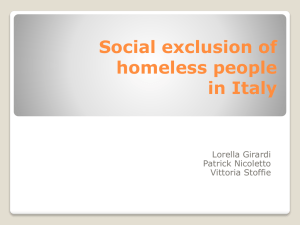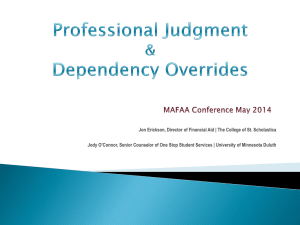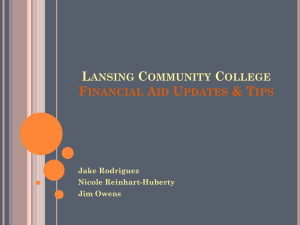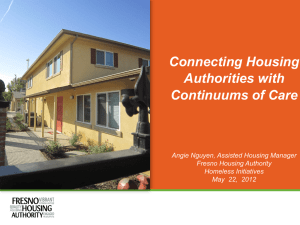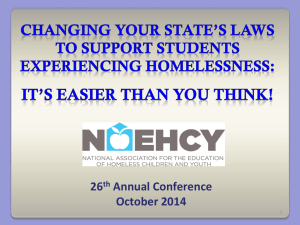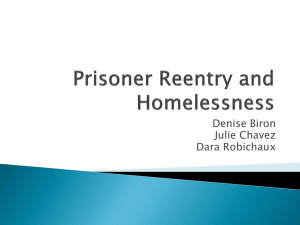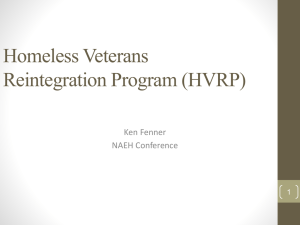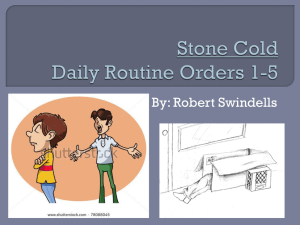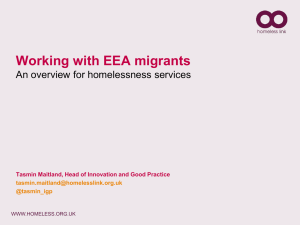The Food Access Project
advertisement
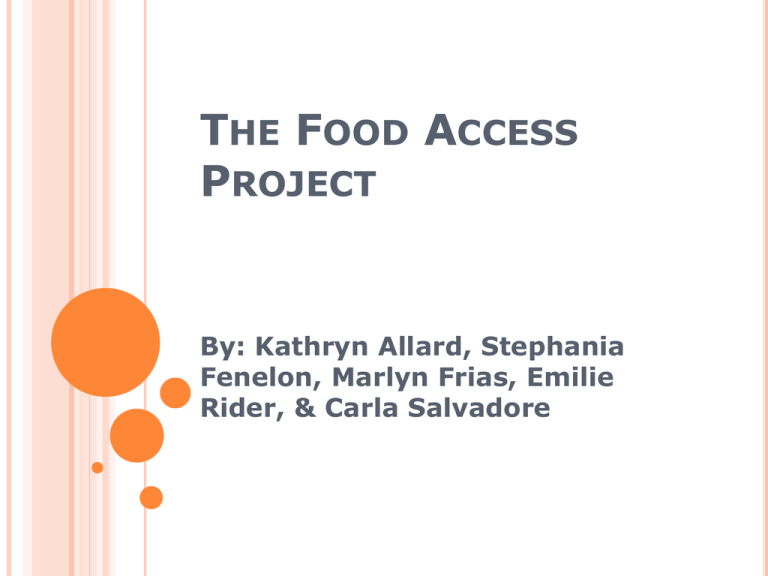
THE FOOD ACCESS PROJECT By: Kathryn Allard, Stephania Fenelon, Marlyn Frias, Emilie Rider, & Carla Salvadore BACKGROUND ON SNAP “Supplemental Nutrition Assistance Program”—Previously known as the Food Stamp Program Established to fight hunger and malnutrition Eligibility for SNAP benefits depends on income Less than 185% of the federal poverty level Benefits are used for food to be purchased and prepared at home Currently SNAP benefits cannot be used to purchase prepared meals THE FOOD ACCESS PROJECT Problem: Individuals that cannot store and prepare their meals at home cannot make use of their SNAP benefits. Homeless Those without kitchens Elderly Disabled Solution: Allow high risk populations to purchase prepared meals with their SNAP benefits. PROJECT MISSION STATEMENT “To decrease hunger and food insecurity for homeless individuals and others who do not have a way to prepare food in Rhode Island.” Short term goal: Access food for those without kitchens and cooking facilities Long term goal: Improve nutrition and the health of the homeless population PROPOSED PILOT PROGRAM Two strategies to increase food access to high risk populations: Strategy 1: Outreach Understanding health and nutrition problems Establish rapport between target population and nursing students Key informant interviews Focus group meetings Health fairs Strategy 2: Work with restaurants and markets to establish contracts for use of SNAP benefits THE NURSING STUDENTS 5 URI senior nursing students Diverse backgrounds Caucasian Native American African American Hispanic Age range 22-26 years old All female WITH FUNDING FROM SOUTHERN RI AHEC… As a team we participated in focus groups, analyzed data, conducted a literature review, and organized health outreach events. Agencies we worked with: Warm Shelter Rhode Island Center Assisting those in Need (RICAN) Welcome House McKinney Shelter Lucy Hearth FOCUS GROUPS Common Themes: Transportation is a problem Primary source of food include soup kitchens and food pantries Nutrition is important Access to water is a concern Salt intake was not a concern SNAP benefits do not help homeless people because there is nowhere to prepare or store foods Being able to get prepared food specifically at subway with food stamps would benefit people who are homeless HEALTH PROMOTION Blood pressure screenings Risk assessment quizzes Hypertension risk Skin cancer risk Summer health tips Hand hygiene Blood glucose readings Body mass index screenings Dental hygiene Nutrition education Healthy eating on a budget Provided nutritious snacks SNAP outreach applications Health related giveaways Raffle BLOOD PRESSURE SCREENINGS Assessment quiz to determine patient’s risk of developing hypertension Exercise, diet, alcohol intake, smoking, weight, age, medications etc. Prior history Screened blood pressure Education Pamphlet Explanation of their reading Lifestyle modifications Referral to primary care provider Answered questions HEALTHY SUMMER TIPS Skin cancer risk assessment Sunscreen use Skin tone and color History of sunburns Family/prior history of skin cancer Skin self assessment education Warning signs of skin cancer Asymmetrical, irregular borders, color, diameter, elevation, family history Sun safety Prevention of vector-borne diseases HAND HYGIENE Described the importance of adequate hand washing The pathogens commonly found on hands When hand washing is necessary Adequate hand washing technique Alternate washing techniques Alcohol gel Hand sanitizers Gave out hand sanitizers for participation BODY MASS INDEX MEASUREMENTS Calculated BMI off of height and weight using a chart from clinical guidelines Advised clients that BMI is a good measurement for overweight and obesity but has limitations Abnormal BMI Informed them of normal values Obtained patient history Strategies to change lifestyle NUTRITION EDUCATION Nutrition pamphlet Food pyramid guidelines Health benefits Tips to healthy snacking Healthy eating on a budget Advising clients on how to purchase nutritious foods in discount supermarkets and farmer markets Gave out fruit for healthy snacks EMPOWERING THE HOMELESS POPULATION IN RI Education, education, education!!! Helps enhance their quality of life and autonomy Established rapport with vulnerable populations Understanding nutritional opinions and practices of the population Important for healthcare professionals to assess the needs of homeless “The best way to find yourself, is to lose yourself in the service of others” -Ghandi REFERENCES Algert, S.J., Reibel, M., & Renvall, M.J. (2006). Barriers to participation in the food stamp program among food pantry clients in Los Angeles. American Journal of Public Health, 96(5), 807-809. Baggett, T., O'Connell, J., Singer, D., & Rigotti, N. (2010). The unmet health care needs of homeless adults: a national study. American Journal of Public Health, 100(7), 1326-1333. Centers for Disease Control and Prevention (2009). Clinical growth charts. Retrieved from http://www.cdc.gov/growthcharts/clinical_charts.htm. Centers for Disease Control and Prevention (2010). Skin cancer. Retrieved from http://www.cdc.gov/cancer/skin/basic_info/prevention.htm. Centers for Disease Control and Prevention (2009). Travelers health. Retrieved from http://wwwnc.cdc.gov/travel/content/mosquito tick.aspx. Dammann, K.W., Smith, C. (2009). Factors affecting low-income women’s food choices and the perceived impact of dietary intake and socioeconomic status on their health and weight. Journal of Nutrition Education and Behavior, 31(4), 242-253. Davis, L.R., Holleman, W.L., Weller, N.F., Jadhav, M. (2008). Dietary intake of homeless women residing at a transitional living center. Journal of Health Care for the Poor and Underserved, 19(3), 952-962. Department of Health and Human Services (2010). Aim for a healthy weight. Retrieved from http://www.nhlbi.nih.gov/health/public /heart/ obesity/lose_wt/index.htm. Fournier, M., Austin, S., Samples, C., Goodenow, C., Wylie, S., & Corliss, H. (2009). A Comparison of Weight-Related Behaviors Among High School Students Who Are Homeless and Non-Homeless. Journal of School Health, 79(10), 466-473. REFERENCES Rank, M., & Hirschl, T. (2005). Likelihood of using food stamps during the adulthood years. Journal of Nutrition Education & Behavior , 37 (3), 137-146. Rhode Island Coalition for the Homeless (2010). Street sheets. Retrieved from http://www.rihomeless.org/Resources/StreetSheets/tabid/172/Default.aspx. Rhode Island Department of Health (2010). Community heath centers in Rhode Island. Retrieved from http://www.health.ri.gov/disease/primarycare/healthcenters.php. Richards, R., Smith, C. (2006). The impact of homeless shelters on food access and choice among homeless families in Minnesota. Journal of Nutrition Education and Behavior, 38(2), 96-105. Savage, C., Lindsell, C., Gillespie, G., Dempsey, A., Lee, R., & Corbin, A. (2006). Health care needs of homeless adults at a nurse-managed clinic. Journal of Community Health Nursing , 23 (4), 225-234. Schwarz, K.B., Garrett, B., Hampsey, J., & Thompson, D. (2007). High prevalence of overweight and obesity in homeless Baltimore children and their caregivers: a pilot study. Medscape General Medicine, 9(1), 48. Stergiopoulos, V., Dewa, C., Tanner, G., Chau, N., Pett, M., & Connelly, J. (2010). Addressing the Needs of the Street Homeless: A Collaborative Approach.International Journal of Mental Health, 39(1), 3-15. Retrieved from Academic Search Premier database. United States Department of Agriculture (2010). My pyramid. Retrieved from http://www.mypyramid.gov/index.html. Weiser, S.D., Bangsberg, D.R., Kegeles, S., Ragland, K., Kushel, M.B., & Frongillo, E.A. (2009). Food insecurity among homeless and marginally housed individuals living with HIV/AIDS in San Francisco. AIDS and Behavior, 13(5), 841-848. Wicks, R., Trevena, L.J., Quine, S. (2006). Experiences of food insecurity among urban soup kitchen consumers: Insights for improving nutrition well-being. Journal of the American Dietetic Association, 106, 921-924. Yousey, Y., Leake, J., Wdowik, M., & Janken, J.K. (2007). Education in a homeless shelter to improve the nutrition of young children. Public Health Nursing, 24(3), 249-255.

